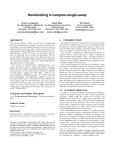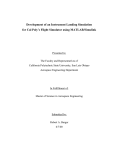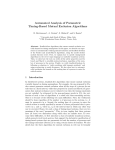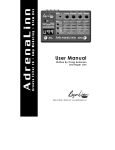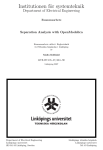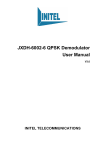Download Efficient non-blocking k-compare-single
Transcript
US 20120278576A1
(19) United States
(12) Patent Application Publication (10) Pub. No.: US 2012/0278576 A1
Shavit et al.
(54)
(76)
(43) Pub. Date:
NOV. 1, 2012
EFFICIENT NON-BLOCKING
K-COMPARE-SINGLE-SWAP OPERATION
(51)
Publication Classi?cation
Int Cl
G06F 12/14
(2006.01)
Inventors:
(52)
US. Cl. ............................... .. 711/163; 711/E12.091
Nir N. Shavit, Cambridge, MA
(US); Mark S. Moir, Somerville,
ABSTRACT
MA (U S); Victor M. Luchangco,
Arlington, MA (Us)
( )
The design of nonblocking linked data structures using
single-location synchronization primitives such as compare
and-sWap (CAS) is a complex affair that often requires severe
restrictions on the Way pointers are used. One Way to address
(21)
Appl' N05
13/543,267
(22)
Filed;
JUL 6, 2012
_
this problem is to provide stronger synchronization opera
tions, for example, ones that atomically modify one memory
location While simultaneously verifying the contents of oth
_
Related U-s- APPhcatmn Data
. . .
57
.
.
(62) Dlvlslon of apphcanon NO‘ 11/864’66_7’ ?led O_n_S_ep'
28’ 2007’ new Pat‘ NO‘ 8,230,421’ Whlch 1S a dlvlslon
OfaPPhCaUOn NO- 10/670,495, ?led On SeP- 24, 2003:
nOW Pat. NO. 7,293,143-
(60) Provisional application No. 60/413,231, ?led on Sep.
24, 2002.
ers. We provide a simple and highly e?icient nonblocking
implementation of such an operation: an atomic k-Word-com
pare single-swap operation (KCSS). Our implementation is
obstruction-free.As aresult, it is highly e?icient in the uncon
tended case and relies on contention management mecha
nisms in the contended cases. It alloWs linked data structure
manipulation Without the complexity and restrictions of other
solutions. Additionally, as a building block of some imple
mentations of our techniques, We have developed the ?rst
nonblocking software implementation of load-linked/store
conditional that does not severely restrict Word siZe.
Patent Application Publication
\VA1@
nAu
Nov. 1, 2012 Sheet 1 0f 2
US 2012/0278576 A1
.wE
m:
.wE
mm
.1
53%
.wE
5
2.
A230“
Patent Application Publication
Nov. 1, 2012 Sheet 2 0f 2
US 2012/0278576 A1
FIG. 3
FIG. 4
a
1
k
b @@__.><--—> c @@/> d
6
Nov. 1, 2012
US 2012/0278576 A1
EFFICIENT NON-BLOCKING
K-COMPARE-SINGLE-SWAP OPERATION
tures, pp. 261-270 (1993). That implementation, as Well as
those of others (see e.g., J. Turek, D. Shasha, and S. Prakash,
Locking without Blocking: Making Lock-based Concurrent
CROSS-REFERENCE TO RELATED
APPLICATION(S)
[0001] This application is a divisional of US. application
Ser. No. 11/864,667, ?led Sep. 28, 2007, Which is a divisional
ofU.S. application Ser. No. 10/670,495, ?led Sep. 24, 2003,
Which claims priority, under 35 U.S.C. §119(e), of US. Pro
visional Application No. 60/413,231, ?led Sep. 24, 2002, all
of Which are incorporated herein by reference in their entirety.
BACKGROUND
[0002]
[0003]
1. Field of the Invention
The present invention relates generally to coordina
tion amongst execution sequences in a multiprocessor com
puter, and more particularly, to techniques for facilitating
implementations of concurrent data structures and/or pro
grams.
[0004] 2. Description of the Related Art
[0005] Interest in atomic multi-location synchroniZation
operations dates back at least to the Motorola MC68030 chip,
Which supported a double-compare-and-sWap operation
Data Structure Algorithms Nonblocking, In Proc. 1 1th ACM
Symposium on Principles ofDatabase Systems, pp. 212-222
(1 992); A. Israeli and L. Rappoport, Disjoint-Access-Parallel
Implementations of Strong Shared Memory Primitives, In
Proc. 13th Annual ACM Symposium on Principles ofDistrib
uted Computing, pp. 151-160 (1994)) Was based on a coop
erative method Where threads recursively help all other
threads until an operation completes. Unfortunately, this
method introduces signi?cant overhead as redundant “help
ing” threads do the Work of other threads on unrelated loca
tions because a chain of dependencies among operations
exists.
[0010] Shavit and Touitou coined the term softWare trans
actional memory (STM) and presented the ?rst lock-free
implementation of an atomic multi-location transaction that
avoided redundant “helping” in the common case, and thus
signi?cantly outperformed other lock-free algorithms. See N.
Shavit and D. Touitou, Software Transactional Memory, Dis
tributed Computing, 10(2):99-116 (1997). HoWever, the
described formulation of STM Was restricted to “static” trans
actions, in Which the set of memory locations to be accessed
(DCAS). See generally, Motorola, MC68030 User’s Manual,
Was knoWn in advance.
Prentice-Hall (1989). A DCAS operation generaliZes a com
pare-and-sWap (CAS) to alloW atomic access to tWo loca
tions. DCAS has also been the subject of recent research. See
obstruction free implementation of a general STM that sup
e.g., O. Agesen, D. Detlefs, C. Flood, A. GarthWaite, P. Mar
tin, M. Moir, N. Shavit, and G. Steele, DCAS-based Concur
rent Deques, Theory of Computing Systems, 35:349-386
(2002); D. Detlefs, P. Martin, M. Moir, and G. Steele, Lock
free Reference Counting, Distributed Computing, 15(4):255
271 (2002); and M. GreenWald, Non-Blocking Synchroniza
tion and System Design, Ph.D. Thesis, Stanford University
Technical Report STAN-CS-TR-99-1624 (1999).
[0006]
In general, the implementation of concurrent data
structures is much easier if one can apply atomic operations to
multiple non-adjacent memory locations. HoWever, despite
the early MC68030 support for DCAS and despite some
research interest multi-location synchronization, current pro
cessor architectures, by and large, support atomic operations
only on small, contiguous regions of memory (such as a
single or double Word).
[0007]
As a result, the current literature offers tWo extremes
of nonblocking softWare synchroniZation support for concur
rent data structure design: intricate designs of speci?c struc
tures based on single-location operations such as compare
and-sWap (CAS), and general-purpose multi-location
transactional memory implementations. While the former are
sometimes ef?cient, they are invariably hard to extend and
generaliZe. The latter are ?exible and general, but typically
costly.
[0008] In an early paper, Herlihy and Moss described trans
actional memory, a more general transactional approach
Where synchroniZation operations are executed as optimistic
atomic transactions in hardWare. See M. Herlihy and J. E. B.
Moss, Transactional Memory Architectural Support for
Lock-free Data Structures, In Proc. 20th Annual Interna
tional Symposium on Computer Architecture (1993).
[0009] Barnes proposed a softWare implementation of a
K-location read-modify-Write. See e.g., G. Barnes, A Method
for Implementing Lock-free Shared Data Structures, In Proc.
5th ACM Symposium on Parallel Algorithms and Architec
[0011]
Moir, Luchangco and Herlihy have described an
ports “dynamic” multi-location transactions. See commonly
oWned, co-pending US. patent application Ser. No. 10/ 621,
072, entitled “SOFTWARE TRANSACTIONAL MEMORY
FOR
DYNAMICALLY
SIZABLE
SHARED
DATA
STRUCTURES” ?led 16 Jul. 2003 naming Mark S. Moir,
Victor Luchangco and Maurice Herlihy as inventors. Moir,
Luchangco and Herlihy have also described an obstruction
free implementation of a multi-location compare-and-sWap
(KCAS) operation, i.e., a k-location compare-and-sWap on
non-adjacent locations. See commonly-oWned, co-pending
US. patent application Ser. No. 10/620,747, entitled
“OBSTRUCTION-FREE MECHANISM FOR ATOMIC
UPDATE OF MULTIPLE NON-CONTIGUOUS LOCA
TIONS IN SHARED MEMORY” ?led 16 Jul. 2003 naming
Mark S. Moir, Victor Luchangco and Maurice Herlihy as
inventors.
[0012] While such obstruction-free implementations can
avoid helping altogether, thereby reducing the algorithm
complexity of the algorithm and eliminating associated over
heads, fur‘ther reductions are desired. Indeed, the strong
semantics of the aforementioned techniques, e.g., full multi
location transaction support, generally come at a cost. Fur
ther, full multi-location transaction support may be overkill
for some important softWare applications such as linked-list
manipulations. What is needed is reasonably e?icient, though
potentially-Weaker, multi-location operations that are general
enough to reduce the design complexities of algorithms based
on CAS alone.
SUMMARY
[0013] We have developed an obstruction-free implemen
tation of an atomic k-location-compare single-sWap (KCSS)
operation. Amongst other things, KCSS alloWs for simple non
blocking manipulation of linked data structures by overcom
ing a key algorithmic dif?culty in their design: i.e., making
sure that While a pointer is being manipulated, neighboring
parts of the data structure remain unchanged. Our implemen
Nov. 1, 2012
US 2012/0278576 A1
tation is ef?cient in the typical uncontended case. For
example, in some realizations, a successful k-location KCSS
contrast With the more conventionally understood nonblock
operation employs only tWo CAS operations, tWo stores, and
ing conditions.
obstruction-freedom, that We noW de?ne, in part, through
2 k noncached loads When there is no contention. Our tech
[0022]
niques are supportable using a variety of single-location
atomic read-modify-Write operations, such as CAS, LL/SC,
is lock-free if after a ?nite number of steps of any execution of
etc. Accordingly, We believe that our results lend themselves
Lock-freedom: An implementation of an operation
that operation, some operation execution completes (irre
spective of the timing behavior of any concurrent operation
to ef?cient and ?exible nonblocking manipulations of list
based data structures using synchronization mechanisms
executions).
available on many current processor architectures. Finally,
is Wait-free if after a ?nite number of steps of any execution of
While KCSS operation semantics provide a useful descriptive
context for our techniques, these techniques apply more gen
erally to transactions that read multiple locations but modify
only a single location.
[0014] In addition, as a building block for some implemen
that operation, that operation execution completes (irrespec
tations of our techniques, We have developed a mechanism for
the dif?culty associated With designing lock-free and Wait
[0023]
Wait-freedom: An implementation of an operation
tive of the timing behavior of any concurrent operation execu
tions).
[0024] A shared data structure is lock-free or Wait-free if all
its operations are lock-free or Wait-free respectively. Much of
emulating load-linked (LL) and store-conditional (SC) opera
free shared data structures is that When concurrent operations
tions for use in an LL/SC synchronization construct. One
interfere With each other, We must ensure that at least one of
interesting exploitation is to provide LL/ SC synchronization
them makes progress (all of them, in the Wait-free case).
Ob struction-freedom relaxes this requirement. We explain in
in a processor that does not directly support load-linked and
store-conditional operations. For example, our techniques
may be used to provide emulation for LL/ SC synchronization
(e.g., to support data structures and softWare designed for
LL/ SC synchronization) on a processor architecture that sup
ports CAS operations. Alternatively, our techniques may be
employed to provide LL/SC synchronization With stronger
semantics than provided by the LL and SC operations directly
supported by a particular processor.
BRIEF DESCRIPTION OF THE DRAWINGS
[0015] The present invention may be better understood, and
its numerous objects, features, and advantages made apparent
to those skilled in the art by referencing the accompanying
draWings.
[0016]
FIGS. 1A and 1B illustrate certain hazards that exist
in attempts to implement, using single-location CAS, non
blocking insertion and deletion operations on a linked list.
[0017] FIGS. 2A and 2B illustrate certain hazards that exist
in attempts to implement, using single-location CAS, non
blocking deletion operations on a linked list.
[0018] FIGS. 3, 4 and 5 illustrate respective uses of exem
plary KCSS operations to simplify the design of a linked-list
construct to support multiset operations.
[0019] The use of the same reference symbols in different
draWings indicates similar or identical items.
DESCRIPTION OF THE PREFERRED
EMBODIMENT(S)
Terminology
[0020] A shared data structure is a collection of data that
can be accessed using an associated set of operations. A
traditional Way to implement a shared data structure is to use
mutual exclusion (locks) to ensure that multiple operations do
not concurrently access (the same part of) the data structure
concurrently. This approach has many disadvantages, as dis
cussed in numerous papers in the literature. A signi?cant
the next section Why obstruction-freedom is a useful property
despite its Weaker progress guarantees.
[0025] Obstruction-freedom: An implementation of an
operation is obstruction-free if every operation execution that
executes in isolation after some point completes after a ?nite
number of steps.
[0026] Observe that all three properties preclude the use of
locks for synchronization because, if an operation acquires a
lock and then fails, any other operation that requires that lock
can never complete, regardless of hoW many steps it takes,
even if it runs alone.
[0027] As applied to transactions, the de?nitions above
need to be extended slightly to preclude the possibility that
every attempt to commit any transaction fails. Speci?cally,
We have the folloWing nonblocking de?nitions for transac
tions.
[0028]
Wait-free transactions: A transaction implementa
tion is Wait-free if all its operations are Wait-free and any
thread that repeatedly attempts to commit transactions even
tually performs a successful commit.
[0029] Lock-free transactions: A transaction implementa
tion is lock-free if all its operations are lock-free and if some
thread repeatedly attempts to commit transactions, then even
tually some thread performs a successful commit.
[0030]
Obstruction-free transactions: A transaction imple
mentation is obstruction-free if all its operations are obstruc
tion-free and if some thread repeatedly attempts to commit
transactions, and runs in isolation after some point, then it
eventually performs a successful commit.
Obstruction-Free Implementations
[0031] Clearly, obstruction-freedom is a Weaker property
than lock-freedom and Wait-freedom. Here, We explain Why
We believe that it is nonetheless an important property to
consider.
[0032] First, We believe that obstruction-free implementa
tions are likely to be substantially simpler to design than
amount of research over the last decade or so has focused on
lock-free and especially Wait-free ones. This has numerous
designing nonblocking shared data structures, Which pre
bene?ts including ease of modi?cation, ease of veri?cation,
etc. In this speci?cation, We describe the ?rst nonblocking
clude the use of locks and thereby avoid their associated
disadvantages.
[0021] Typically, tWo nonblocking conditions, lock-free
implementation of dynamic softWare transactional memory
(STM); our implementation guarantees obstruction-freedom
dom and Wait-freedom, have been considered in the literature.
but not lock-freedom. It is simpler and more ef?cient than
In this description, We focus on a neW nonblocking condition,
lock-free implementations of static STM.
Nov. 1, 2012
US 2012/0278576 A1
[0033]
Second, in some scenarios, We can exploit proper
ties of the environment to ensure that every obstruction-free
plify the design of nonblocking algorithms by removing the
need to provide strong progress guarantees in the algorithm
operation execution completes. For example, in a uniproces
itself (as required by Wait-freedom or lock-freedom). Simply
sor Where threads are scheduled by time slice, relatively short
obstruction-free operations may be guaranteed to run alone
put, obstruction-freedom guarantees a thread’s progress if
other threads do not actively interfere for a suf?cient period.
The de?nition is thus geared toWards the uncontended case,
for long enough to complete. Another example is in priority
scheduled uniproces sors: an operation runs in isolation unless
handling contended cases through orthogonal contention
it is preempted by a higher priority operation.
management mechanisms. Lock-based algorithms are not
Third, in some scenarios, We might reason that, even
obstruction-free because a thread trying to acquire a lock can
though the system does not guarantee operations Will run in
isolation for long enough to complete, We may determine by
analysis or experiments that the “livelock” scenario that lock
freedom precludes but obstruction-freedom admits does not
be blocked inde?nitely by another thread that holds the lock.
On the other hand, a lock-free algorithm is also obstruction
free because lock-freedom guarantees progress by some
thread if some thread continuously take steps.
occur in practice.
[0035] Finally, an obstruction-free implementation can be
augmented With a variety of different mechanisms that
attempt to control the interactions betWeen concurrent opera
A Motivating Example
[0034]
Manipulating Linked Data Structures
tions in order to ensure that operations eventually complete. A
simple example is to use “backoff.” Using this approach,
[0039]
operations Wait before retrying upon encountering interfer
manipulation; it alloWs a thread, While modifying a pointer, to
check atomically that related nodes and pointers have not
ence. Various schemes can be chosen for deciding hoW long to
Wait. One choice is a combination of randomization and
KCSS is a natural tool for linked data structure
changed. An exploitation of general applicability is the imple
exponential back off, Which is very likely to cause operations
to run long enough in isolation to complete. Such schemes
can be effective for improving the performance of lock-free
mentation of nonblocking linked data structures With arbi
trary insertions and deletions.
implementations by reducing contention, and We expect that
they Will be similarly effective in alloWing obstruction-free
FIGS. 1A and 1B illustrate some of the haZards that exist in
operations to complete. Other “out of ban ” contention
reduction mechanisms can also be employed, including
mechanisms yet to be developed. The beauty of our approach
is that the obstruction-free implementations themselves Will
not have to be modi?ed (and therefore Will not have to be
reveri?ed) in order to use a different contention reduction
mechanisms.
[0040]
Examples presented in FIGS. 1A and 1B and in
straight-forward (though ultimately nai've) attempts to imple
ment, using single-location CAS, nonblocking insertion and
deletion operations on a simple linked list. The examples are
meant to illustrate that CAS-based manipulation of a list is
hard. Circled locations indicate the target addresses of CAS
operations; crossed out pointers are the values before a CAS
succeeds.
time stamping approaches, in Which threads agree amongst
[0041] In the example of FIGS. 1A and 1B, process (or
thread) P is deletes node b from the list, While process (or
thread) Q concurrently attempts to insert node c into the list.
themselves to “Wait” for each other to ?nish. While simplistic
applications of these ideas Would give rise to some of the
FIG. 1A illustrates partial sequences of instructions corre
sponding to processes P and Q, each including a CAS opera
same problems that the use of locks does, We have much more
tion intended to facilitate concurrent access to the list. FIG.
freedom in designing more sophisticated approaches for con
tention reduction than When using locks, because correctness
is not jeopardized by interrupting an operation at any time and
alloWing another operation to continue execution. We expect
1B illustrates the unintended results of the concurrent access;
node c is not inserted in the list, but rather linked from deleted
node b. FIGS. 2A and 2B illustrate an analogous competition
[0036] Other possible approaches include queuing and
that contention betWeen operations Will typically be quite
betWeen deleting processes. Process (or thread) P is deletes
node b from the list While process (or thread) Q concurrently
rare, and that repeated retries Will rarely be necessary. In
scenarios Where this is true, We bene?t from the simple and
attempts to delete node c. FIG. 2B likeWise illustrates the
unintended results of the concurrent access; node c is not
e?icient obstruction-free designs and only rarely invoke the
deleted from the list, but rather remains linked from node a.
more heavy-Weight contention reduction mechanisms. In
contrast, in most lock-free and Wait-free implementations, the
[0042] In short, the naive CAS based implementations sim
ply do not Work. Although effective (and rather ingenious)
mechanisms that are used to ensure the respective progress
nonblocking algorithms do exist for ordered list-based sets
properties impose signi?cant overhead in the typical case.
[0037] Accordingly, building on these insights, We have
(see e.g., T. Harris, A Pragmatic Implementation 0fN0n
single-modi?cation transactions, including nonblocking
blockingLinked Lists, In Proc. 15th International Symposium
on Distributed Computing (2001); and M. Michael, High
Performance Dynamic Lock-free Hash Tables and List-based
implementations structured as an atomic k-location-compare
Sets, In Proc. 14th Annual ACM Symposium on Parallel
single-sWap (KCSS) operation. KCSS veri?es the contents of k
locations and modi?es one of them, all as a single atomic
Algorithms and Architectures, pages 73-82 (2002)), these
algorithms do not generaliZe easily to arbitrary linked data
operation. One implementation of KCS S, When executed With
out contention, requires only tWo CAS operations, tWo stores,
algorithms to implement multisets.
and 2 k non-cached loads. It requires no memory barriers
under the TSO memory model.
plify the design of arbitrary nonblocking linked-list opera
developed simple, ef?cient nonblocking implementations of
[0038]
The nonblocking progress condition that our imple
structures. For example, it is not clear hoW to modify these
[0043]
By employing KCSS instead of CAS, We can sim
mentation meets is obstruction-freedom. As detailed above,
tions. In particular, KCSS alloWs us to con?rm that other
pointers of the illustrated lists remain unchanged at a linear
obstruction-freedom is a progress condition that tends to sim
iZation point at Which We atomically perform the single sWap
Nov. 1, 2012
US 2012/0278576 A1
used to effectuate the insert or delete operation. Furthermore,
more complex data structures may also be supported.
[0044] FIGS. 3, 4 and 5 illustrate how the use ofKCSS can
signi?cantly simplify the design of a linked-list construct to
support multiset operations. Each element in the multiset
(i.e., an element with nonZero multiplicity) is represented by
a node in the list, which stores the element’s multiplicity in a
count ?eld. Inserts or deletes of such elements respectively
increment or decrement the count (FIG. 3). Two- and four
location KCSS operations are used to add and remove nodes by
swapping one pointer, while con?rming nearby nodes have
not changed (FIGS. 4 and 5). For simplicity, the illustrated
implementation uses a 4CSS operation to make sure the adja
cent nodes have not changed during node removal. We can
achieve the same purpose using KCSS operations that access
only two locations at the cost of a slightly more intricate
tion. The behavior of all operations is unde?ned if LL or KCSS
is invoked by process p while p has outstanding LL operation
on any location. While, it is straightforward to remove this
restriction (see e.g., M. Moir, Practical Implementations of
Non-blocking Synchronization Primitives, In Proc. 16th
Annual ACM Symposium on Principles of Distributed Com
puting, pp. 219-228 (1997) (presenting an ef?cient technique
for generaliZing LL/ SC implementations so that LL/ SC
sequences can be executed concurrently on different loca
tions)), retaining it simpli?es our presentation. Accordingly,
for simplicity of description and without limitation, we
assume that LL and SC are used in pairs on the same location.
[0050] The behavior of an SC(a) operation S by process p is
unde?ned if it is invoked before any LL(a) operation by pro
algorithm. However, adding a small number of additional
cess p has completed, or if there is not a previous LL(a)
operation L by process p such that there is no LL, SC or KCSS
locations to a KCSS operation is not prohibitive because, as
operation invoked by process p between L and S. Otherwise,
illustrated below, the cost of verifying each additional loca
tion is quite low, only two noncached loads. In many cases,
an SC(a) operation by process p returns true only if no other
operation that changes the abstract value of location a has
this is a reasonable tradeoff.
occurred since the preceding LL(a) operation by process p. We
In designing some implementations of our KCSS
say that a SC operation succeeds if it returns true, and fails
algorithm, we provide a simple and novel implementation of
otherwise. To ensure that this operation is useful for imple
menting obstruction-free data structures, we further require
that an SC(a) operation succeeds if no other operation that
[0045]
load-linked/store-conditional (LL/ SC) using CAS synchroni
Zation; this implementation improves on previous results in
that it can accommodate pointer values on all common archi
accesses location a takes a step between the invocation of p’s
tectures. In particular, ABA avoidance tags or ids need not be
preceding LL(a) operation and the completion of the SC(a)
encoded integrally with pointer representations. We believe
this algorithm is of independent signi?cance: it extends the
operation. Observe that this speci?cation allows a concurrent
applicability of LL/SC-based algorithms to all common
architectures that support CAS.
would do so in our implementation. Although this possibility
READ(a) operation to cause a SC(a) operation to fail; in fact, it
does not jeopardize obstruction-freedom, eliminating it
would allow some concurrent operations to succeed that
Preliminaries
[0046] A k-location-compare single-swap (KCSS) opera
would otherwise fail, and thus, may be desirable. As later
described, our implementation can easily be modi?ed to
come close to this goal.
tion takes k locations al . . . ak, k expected values el . . . ek, and
a new value n1. If the locations all contain the expected values,
the KCSS operation atomically changes the ?rst location al
from el to nl and returns true; in this case, we say that the KCSS
succeeds. Otherwise, the KCSS returns false and does not
modify any memory location; in this case we say that it fails.
In the next section, we present an implementation for KCSS
using particular read, load-linked (LL), store-conditional
(SC) and snapshot operations that we have also implemented.
In this section, we describe more precisely the interface and
[0051] A SNAPSHOT(m, a[l . . . m]) operation returns an
array V [l . . . . m] such that, for each ie[l,m], V[i] is the
abstract value of location a[i]. The locations speci?ed by a
must be distinct.
Correctness Condition
[0052] Below we present obstruction-free, lineariZable
implementations of the operations described above. Linear
iZability implies that each operation appears to take effect
semantics of the various operations, the correctness require
ments, and our assumptions about the system.
response; this point is the operation’s lineariZation point.
Operation Semantics
operation, and after some point p runs without interference
instantaneously at some point between its invocation and its
Obstruction-freedom requires that if a thread p executes an
[0047] We now describe the semantics of the operations for
which we provide implementations in the next section. We
consider a collection of locations. At any point in time, each
for long enough, then that operation will terminate.
Interoperability with Dynamic Data Structures and Memory
location has an abstract value from a set of application values.
As explained below, our implementation assumes some mild
[0053] In our implementations of the above operations,
each location initially holds its initial abstract value. Thus,
restrictions on this set.
locations can be dynamically allocated and initialiZed by a
Management
A KCSS(k, a[l . . . k], expvals[l . . . k], newval)
single thread, which is important for dynamic-siZed data
operation returns false if for some ie[l,k], the abstract value
structures. Our implementations also allow a location to be
freed if no operation that speci?es this location as an argu
[0048]
of location a[i] differs from expvals[i]. If this operation
returns true, then it also changes the abstract value of location
a[l] to newval. The locations speci?ed by a must all be
distinct.
[0049]
READ(a) and LL(a) operations return the abstract
value of location a. An LL operation of thread p is said to be
outstanding until p invokes an SC operation on the same loca
ment is executing or will be invoked. Furthermore, they guar
antee that there will always be a pointer to an object that could
be accessed in the future. Thus, our operations do not affect
memory management, and in particular, data structures based
on our implementations “play nicely” with garbage collection
and nonblocking memory management techniques. The gar
Nov. 1, 2012
US 2012/0278576 A1
bage collector Would need to be modi?ed slightly to distin
guish between pointers and tagged ids, Which are described
[0060] Each location can store either an application value
or a tagged process id. The abstract value of a location that
contains an application value is alWays that value; When the
below.
location contains a tagged id, it is a little more complicated, as
System Model
We explain beloW. A tagged process id (tagged id for short)
[0054]
contains a process id and a tag.
We assume a machine architecture (typically a
shared memory multiprocessor) that supports lineariZable
load, store, and CAS operations. It is straightforward to trans
form these algorithms to Work in systems that provide LL and
SC rather than CAS. In this case, native LL and SC operations
should be directly used to replace the use of CAS in our
implementations. Native LL and SC operations do not replace
our implementations of the LL and SC operations because our
implementations of these operations include additional func
tionality designed to be compatible With the SNAPSHOT opera
tion. Appropriate LL/ SC for CAS substitutions are knoWn in
the art (see e.g., M. Moir, Practical Implementations ofNon
blocking Synchronization Primitives, In Proc. 16th Annual
ACM Symposium on Principles of Distributed Computing,
pp. 219-228 (1997)).
[0055] The semantics of a CAS operations Will be under
stood With reference to the folloWing atomic code fragment:
bool CAS(loc *a, value expval, value neWval) {
[0061]
The only restriction We place on application values
is that We have some Way to distinguish them from tagged ids.
One simple Way to achieve this When the application value of
interest is a pointer is to “steal” the loW-order bit to mark
tagged ids: We can arrange that all locations are aligned on
even byte boundaries so that the loW-order bit of every pointer
is Zero (locations that Will be targets of CAS instructions are
usually required to be Word-aligned anyWay).
[0062] For convenience, We treat tags as if they Were
unbounded integers. In today’s 64-bit architectures, We can
use one bit to distinguish tagged ids, 15 bits for the process id
and 48 bits for the tag, Which is more than enough to avoid the
ABA problem that potentially arises as the result of tags
Wrapping around.
LL and SC
[0063] We noW explain a simpli?ed version of our imple
mentations of the LL and SC operations using the code that
folloWs.
atomically{
if (*a != expval)
return false;
*a = neWval;
typedefstruct locis {
taggedidit tid; // used for SNAPSHOT
valueit val; // atomically CASable
return true;
} locit;
void RESET(locit *a) {
1: valueit oldval = a—>val;
2: if(TAGGEDiID(oldval))
3:
CAS (&a—>val, oldval, VALiSAVE[ID(oldval)]);
[0056] Although We assume lineariZability, our algorithms
are correct on multiprocessors that provide only the TSO
memory model, Without adding memory barrier instructions;
valueit LL(locit *a) {
this is a side effect of the Way We use CAS.
4: While (true) {
5:
INCLMYLTAGGEDLID; // increment local tag
An Exemplary Implementation
valueit val = READ(a);
VALiSAVE[MYiID] = val;
[0057]
if (CAS(&a->val, val, MYiTAGGEDiID» {
We noW describe our implementations of the READ,
a—>tid = MYLTAGGEDLID; // needed for SNAPSHOT
LL, SC, SNAPSHOT, and KCSS operations. We begin by explain
ing a restricted version of the LL, SC, and READ operations,
Which is correct if We need only these operations. We then
explain hoW LL can be modi?ed slightly to support a simple
SNAPSHOT operation. Finally We explain hoW We implement
return val;
}
bool SC(locit *a, valueit neWval) {
11: return CAS (&a—>val, MYLTAGGEDLID, neWval);
KCSS using LL, SC, and SNAPSHOT.
[0058]
Recall that an SC(a,v) operation by process p should
succeed only if no other operation that modi?es location a is
linearized betWeen the lineariZation points of p’s preceding
LL(a) operation and p’s SC(a,v) operation. To overcome the
ABA problem, previous implementations of LL/ SC from
CAS have employed special “tags” or “version numbers” to
be stored together With the application value in a location that
can be accessed by CAS. This requirement severely restricts
the range of values that can be stored by those SC implemen
tations, and in particular, makes these implementations inap
plicable for storing pointers in many architectures.
[0059] Our goal is to design implementations that place
valueit READ (locit *a) {
12: While (true) {
13:
valueit val = a—>val;
14:
15:
if (!TAGGEDiID(val)) retum val;
RESET(a);
[0064]
For the purposes of this simpli?ed version, the
reader should ignore the tid ?eld of the location record (i.e., a
location record is simply a memory location that contains an
application value or a tagged id), and any code that accesses
much milder restrictions on the set of application values, in
it, namely line 9.
[0065] In order to implement LL(a) and SC(a,v) operations
particular so that our implementations can access pointers on
for process p, We need a Way to determine Whether the
all common multiprocessor architectures. BeloW We specify
these restrictions, Which are too Weak to alloW tag/version
number techniques, and then explain hoW We can achieve our
abstract value of location a has changed since the LL(a) opera
tion Was linearized. Our approach is to have p’s LL(a) opera
tion store a previously unused tagged id in location a (line 8).
We ensure that the tagged id is neW by having p maintain a
implementations despite these Weaker restrictions.
Nov. 1, 2012
US 2012/0278576 A1
local tag, Which it increments each time it needs a neW tagged
explained later, this is useful to support the SNAPSHOT and
id (line 5). As explained below, We do not alloW any operation
KCSS operations that are presented next.
that changes the abstract value of location a to be linearized
While the tagged id of another process is in that location.
SNAPSHOT
Thus, if the SC(a,v) operation changes the contents of location
a from the tagged id stored by the preceding LL(a) of the same
process to V (i.e., the CAS in line 1 1 succeeds), then it changes
the abstract value of location a to V While ensuring that the
abstract value of location a has not changed since the previous
LL(a) operation, as required.
[0066] To guarantee obstruction-freedom, it is not su?i
cient to prevent other operations from being linearized
betWeen the lineariZation points of p’s LL(a) and SC(a,v)
operations: We must guarantee that a thread that runs Without
interference Will make progress. Therefore, it must be pos
sible for a concurrent operation to remove p’s tagged id from
location a (thereby causing p’s SC to fail), Without changing
the abstract value of location a; this is achieved by the auxil
iary RESET operation, Which is explained beloW. To make
this possible, before attempting to store a neW tagged id in
location a, p’s LL(a) operation ?rst stores the application value
it intends to replace With its tagged id (line 6) in a special
location VALiSAVE[p] (line 7). (Recall that p can have at most
one outstanding LL operation, so a single location is su?i
cient.) For noW, We can consider the abstract value of a loca
tion that contains a tagged id of process p to be VALiSAVE[p].
Thus, it is easy to see that When p’s LL(a) operation replaces
the application value in location a With a tagged id (line 8), the
abstract value of location a does not change. Similarly,
another operation that uses CAS to remove p’s tagged id can
correctly determine the abstract value of location a in order to
[0069] We have adapted a Well-knoWn nonblocking tech
nique, see Y. Afek, H. Attiya, D. Dolev, E. Gafni, M. Merritt,
and N. Shavit, Atomic Snapshots ofShared Memory, Journal
of the ACM (JACM), 40(4):873-890 (1993), to obtain an
atomic snapshot of a number of locations. We repeatedly
“collect” (i.e., read each location individually and record the
values read) the values from the set of locations until We
encounter a collect in Which none of the values collected has
changed since it Was read in the previous collect. In this case,
it is easy to see that, When the ?rst value is read in the last
collect, all of the values read during the previous collect are
still in their respective locations. A tricky detail is hoW to
determine that a value has not changed since the last time it
Was read. Because of the ABA problem, it is not su?icient to
simply determine that the tWo values read Were the same: the
location’s value may have changed to a different value and
then changed back again betWeen these tWo reads. As
explained beloW, We can determine a value has not changed
using the tid ?eld (Which We have been ignoring until noW)
associated With each location. This ?eld serves the same
purpose as the tags (or version numbers) discussed earlier.
HoWever, our implementation does not require them to be
modi?ed atomically With the val ?eld, and therefore does not
restrict applicability, as discussed earlier.
[0070] Exemplary code for SNAPSHOT folloWs.
replace p’s tagged id With the correct abstract value by read
ing VALiSAVE[p] (line 3). (Process p does not change VALi
SAVE[p] While any location contains its tagged id. Also, there
is no ABA problem When either p or another process removes
p’s tagged id from location a, because p uses a fresh tagged id
each time it stores a tagged id in location a and only process
p stores a tagged id With p’s process id.)
[0067] This completes the description of the LL(a) and SC(a,
v) operations, except that We have not explained the READ(a)
operation, Which is used by LL(a) (line 6).
READ
[0068] The READ operation determines the abstract value of
location a. It ?rst reads location a (line 13). If the value read
is an application value, then this Was the abstract value of
location a When line 13 Was executed, so it can be returned
= COLLECTiTAGGEDiIDS (m,a);
S7:
VA[1 ..m] = COLLECTiVALUES(rn,a);
S8:
VB[l..m] = COLLECTivALUES(m,a);
S9:
$10:
TB[1 ..m] = COLLECTiTAGGEDiIDSQma);
if (for all i, (TA[i] == TB [i]) &&
(line 14). Otherwise, the abstract value of location a When line
13 Was executed Was VALiSAVE[p] Where p is the process
Who se id is in the tagged id read at line 13. Simply reading that
location Would not necessarily provide the correct abstract
value of location a because p might have changed the contents
of this location since the READ(a) operation executed line 13.
(VA[i] == VB [i]))
return VA;
S1 1:
}
}
[0071]
Observe that the basic structure (if We ignore tags
HoWever, because there can be no ABA problem on tagged
for a moment longer) is essentially as described above: We
ids, the READ(a) operation could read VALiSAVE[p] and then
collect the set of values tWice (lines S7 and S8) and retry if any
of the values changed betWeen the ?rst read and the second
(line S10). Observe further that COLLECTiVALUES uses READ
to read the value of each location. Thus, it ensures that the
reread location a to con?rm that the same tagged id is still in
location a. In this case, it could correctly lineariZe a read of the
abstract value of location a at any point betWeen the tWo reads
of location a. If We Wanted to support only LL, SC, and READ
operations, this Would be correct and Would alloW a location
to be read Without causing a concurrent LL/SC sequence on the
same location to fail. HoWever, in code above, if a READ
operation encounters a tagged id, it calls RESET in order to
attempt to set location a back to its abstract value. As
abstract value it reads from a location a is stored in location a
itself. As described earlier, for the abstract value of a location
to change, some process must install a fresh tagged id in that
location and subsequently change that tagged id to the neW
abstract value. This entire sequence must occur betWeen the
READ in the ?rst collect and the READ in the second. Therefore,
Nov. 1, 2012
US 2012/0278576 A1
line 9 of the LL operation, Which stores the fresh tagged id in
the tid ?eld of the location, must be executed betWeen the ?rst
and second reads of the tid ?eld by the SNAPSHOT operation,
requirement someWhat; We have presented our implementa
tions Without these modi?cations in order to keep the presen
tation simple and clear.
Which Will therefore retry (see lines S6 and S9). This argu
ment is simple, but it depends on the fact that READ resets a
location that contains a tagged id. BeloW, We explain hoW our
Variations
implementation can be modi?ed to avoid this requirement.
[0075] We have presented a simple and e?icient nonblock
ing implementation of a dynamic collection of locations that
KCSS
supports READ, LL, SC, SNAPSHOT and KCSS operations. We
have also explained a simple extension by Which We can
support transactions that modify at most one location. These
[0072] Our KCSS implementation can be built using the
operations described above and Will be understood With ref
erence to the exemplary code that folloWs:
bool KCSS(int k, (locit *) a[l..k],
valueit expvals[l..k] , valueit neWval){
valueit oldvals[l..k] ;
Kl: While (true) {
K2:
K3:
oldvals[l] = LL(a[l]);
oldvals[2..k] = SNAPSHOT(k-l,a[2..k]);
K4:
if (for some i, oldvals [i] != expvals[i]) {
K5:
SC(a[l], oldvals[l]);
K6:
return false;
// try to commit the transaction
K7:
if (SC(a[l], neWval)) return true;
]> // end While
}
operations form a poWerful set of tools for designing rela
tively simple obstruction-free implementations of important
shared data structures such as linked lists. Because of the Way
in Which We solve the ABA problem, our implementation is
more ef?cient, more ?exible, and more Widely applicable for
implementing linked data structures than the techniques used
in recent direct implementations of lock-free linked lists.
[0076] From the basic ideas We have presented in this
paper, numerous possible optimiZations, extensions, and gen
eraliZations are possible. We describe a feW of them here.
Optimizing READ
[0077]
Our READ operation can be optimiZed by observing
that if the CAS in line 3 thereof succeeds, then We have
already determined the abstract value of the location being
accessed, Which can be returned immediately Without reread
1ng.
[0073]
The implementation itself is straightforward, but the
lineariZation argument is trickier. The basic idea is to use LL
Improving Concurrency
and SC to change the value of location a[l] from expvals[l] to
[0078]
neWval (lines K2 and K7), and to use SNAPSHOT to con?rm
so that READ does not alWays have to reset a location that
that the values in locations a[2 . . .k] match expvals[2 . . .k]
contains a tagged id: in some cases, reading a value from the
VALiSAVE location of the process Whose tagged id is encoun
(lines K3 and K4). If any of the k values is observed to differ
from its expected value (line K4), then the KCSS and returns
false, as required (line K6). However, before returning, it
attempts to restore a[l] to expvals[l] using SC (line K5), so
that the previous LL operation is no longer outstanding, and
thus, the process may subsequently invoke another LL or KCSS
operation.
[0074]
If the SC in line K7 succeeds, then We knoW that the
abstract value of location a[l] is expvals[l] for the entire
As stated earlier, We can modify our implementation
tered, and then con?rming that the tagged id is still in the
location is su?icient to determine the correct abstract value.
This does not Work, hoWever, in cases in Which We lineariZe a
modi?cation to the location accessed by a LL/SC pair at a point
other than the lineariZation point of the SC operation. In the
operations We have presented, this is the case only for LL/SC
sequences that are part of a higher-level KCSS operation.
Therefore, if We extend the interface of LL so that the invoker
can specify Whether or not this is a “dangerous” use of LL/SC,
interval betWeen the lineariZation point of the LL in line K2
and the lineariZation point of the SC in line K7. In particular,
this holds at the lineariZation point of the SNAPSHOT called in
then this information could be stored in the tagged id. Thus,
line K3, When the abstract values of a[2 . . . k] match expvals[2
proceed concurrently.
. . . k]. Thus, We can lineariZe the successful KCSS operation at
[0079] This modi?cation Would complicate the SNAPSHOT
implementation slightly. Recall that the argument given ear
that point. This is Where the lineariZation argument becomes
slightly tricky: The actual value in location a[l] does not
change to neWval until the SC in line K7 is linearized. HoW
ever, the abstract value of that location changes at the linear
iZation point of the KCSS operation, Which occurs earlier.
Therefore, if any other operation observes the abstract value
of that location betWeen the lineariZation points of the SNAP
SHOT in line K3 and the SC in line K7, it Will see the Wrong
abstract value and the implementation Will not be lineariZ
able. To prevent this problem, We require READ to reset a
READ could reset only When it encounters such LL/SC
sequences, While alloWing other, simpler uses of LL/SC to
lier for the lineariZability of SNAPSHOT operations depends on
READ alWays resetting a location if it contains a tagged id. This
can be overcome by having SNAPSHOT also collect the tagged
ids from locations for Which it has determined values Without
resetting the location. As this Wouldbe done only if the tagged
id is in the location on behalf of a nondangerous LL/SC
sequence, the abstract value of the location does not change
before that tagged id is removed from the location, so it is
suf?cient for SNAPSHOT to con?rm that it has not.
location, rather than simply reading the VALiSAVE entry of
the process Whose tagged id is in the location, and then
con?rming that the tagged id is still in the location (as
DCSS and CAS
described earlier). This ensures that no process observes the
Wrong abstract value in the interval betWeen the SNAPSHOT
and the successful SC. As described beloW, We can relax this
(DCSS) operation (i.e., KCSS With k:2), We can replace the
[0080]
To implement a double-compare single-sWap
SNAPSHOT of k— l :1 location in our KCSS implementation With
Nov. 1, 2012
US 2012/0278576 A1
a simple READ. Similarly, for a CAS on these locations, Which
putational system. Accordingly, such terms and invariants
is simply a KCSS operation With kIl, the snapshot can be
eliminated entirely.
Will be understood in the context of consistent states pre
sented by a given computational system rather than as a
[0081]
requirement for precisely simultaneous effect of multiple
In some cases, such as the multiset example men
tioned earlier, locations that support only read, CAS and
state changes. This “hiding” of internal states is commonly
DCSS operations are suf?cient. In cases such as this one, We
referred to by calling the composite operation “atomic”, and
can eliminate the tid ?eld (and the code that accesses it), as
this ?eld Was used only for the SNAPSHOT operation. We can
by allusion to a prohibition against any process seeing any of
the internal states partially performed.
also implement CAS by using the native CAS instruction,
[0086] In some embodiments, the current invention may
comprise a computer program product embodied in one or
more computer readable media.
resetting the location if it contains a tagged id.
Optimizations to SNAPSHOT and KCSS
[0087] Many variations, modi?cations, additions, and
improvements are possible. For example, While application to
[0082] The implementation of SNAPSHOT can be improved
at the cost of muddying the presentation slightly. For
example, the tags collected at line S9 can be used for the ?rst
set of tags in the next iteration (We collect the tags again in the
next iteration at line S6). Also, one can eliminate a complete
sequence of reads from the snapshot, at the cost of a slightly
more complex proof. We can also improve the performance of
the KCSS by breaking the snapshot abstraction (for example,
there is no need to take an entire snapshot if one of the early
values read does not match the expected value).
Single Modi?cation Transactions
particular concurrent shared objects and particular imple
mentations thereof have been described, applications to other
shared objects and other implementations Will also be appre
ciated by persons of ordinary skill in the art. While much of
description herein has focused on compare and sWap (CAS)
based synchronization, other synchronization primitives may
be employed. For example, based on the description herein,
persons of ordinary skill in the art Will appreciate that other
suitable constructs, including load-linked and store-condi
tional operation pairs (LL/SC) may be employed, as Well.
Plural instances may be provided for components, operations
or structures described herein as a single instance. Finally,
[0083] We chose the KCSS API to demonstrate our ideas
because its semantics is easy to state and understand. HoW
ever, the ideas presented here can be extended to support
boundaries betWeen various components, operations and data
transactions that modify only a single location. The basic idea
tions. Other allocations of functionality are envisioned and
is to have transactional loads record the information collected
in the ?rst half of the snapshot in our KCSS implementation,
and transactional commit do the second half of the snap shot to
determine if any of the values read had been modi?ed by a
may fall Within the scope of the invention(s).
[0088] In general, structures and functionality presented as
concurrent operation since being read by the transactional
load. Interestingly, the implementation of this stronger
larly, structures and functionality presented as a single com
ponent may be implemented as separate components. These
stores are someWhat arbitrary, and particular operations are
illustrated in the context of speci?c illustrative con?gura
separate components in the exemplary con?gurations may be
implemented as a combined structure or component. Simi
semantics Would actually be someWhat more ef?cient than
and other variations, modi?cations, additions, and improve
using READ and KCSS for the same purpose, because the READS
ments may fall Within the scope of the invention(s).
and the ?rst half of the snap shot in KCSS are collapsed together
into the transactional load. It Would also be straightforWard to
provide a transactional “validate” operation that rechecks the
values read so far in the transaction.
1.-47. (canceled)
48. A non-transitory computer-readable storage medium
storing one or more instruction sequences executable on a
multiprocessor to implement a linearizable, non-blocking
[0084] We believe that the ability provided by KCSS to “con
?rm” the abstract value of some locations, While modifying
synchronization operation con?gured to:
an-other, Will signi?cantly reduce the impact of ABA issues
on algorithm designers. HoWever, such issues may still arise
and
modify, at most, one of the locations.
in some cases, and implementing the transactions as dis
cussed above Would completely relieve designers of the bur
den of dealing With this problem.
Other Embodiments
[0085]
While the invention(s) is(are) described With refer
verify contents of a plurality of targeted memory locations;
49. The non-transitory computer-readable storage medium
of claim 48, Wherein the plurality of targeted memory loca
tions comprises three or more memory locations.
50. The non-transitory computer-readable storage medium
of claim 48, Wherein the one or more instruction sequences
comprise program instructions executable on the multipro
cessor to implement a k-compare, single-sWap (KCSS)
ence to various implementations and exploitations, it Will be
operation.
understood that these embodiments are illustrative and that
the scope of the invention(s) is not limited to them. Terms
such as alWays, never, all, none, etc. are used herein to
describe sets of consistent states presented by a given com
of claim 48,
putational system, particularly in the context of correctness
proofs. Of course, persons of ordinary skill in the art Will
recognize that certain transitory states may and do exist in
physical implementations even if not presented by the com
51. The non-transitory computer-readable storage medium
Wherein, in an uncontended execution thereof, the non
blocking synchronization operation employs no more
than tWo single-location synchronization operations.
52.-106. (canceled)
*
*
*
*
*












